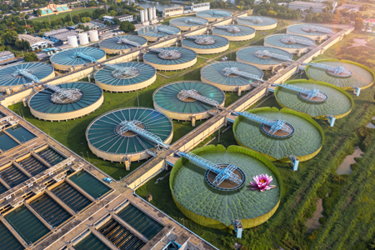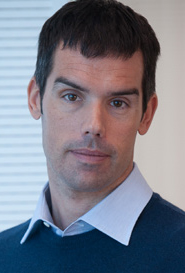Being Resourceful With Wastewater Treatment To Help Tackle The Global Water Crisis
By Marco Achilea

Trends toward efficiency and digitalization within the wastewater treatment industry promise improved operations, a healthier environment, and a more sustainable future.
Wastewater can be a valuable but often untapped resource in helping to solve our global water shortage. When treated effectively, it can be returned safely to the water cycle for reuse, reducing the levels of untreated sewage pumped into rivers and oceans and therefore mitigating the negative impact on public health, the environment, and marine life.
Projected to grow from $300 billion in 2022 to $490 billion by 2029,1 the wastewater market holds great potential as a key part of the solution to our water scarcity crisis. However, the UN estimates that, globally, only 52% of wastewater is currently treated.2 This puts increased demand on freshwater and means that untreated wastewater continues to contaminate the natural environment.
With the UN predicting a global water deficit of 40% by 2040,3 we have a collective responsibility to contribute to the UN’s Sustainable Development Goal 6.3 of halving the proportion of untreated wastewater by 2030.
Balancing Wastewater Treatment With Cost And Carbon Consumption
With a growing population and industry demanding more water, it is critical now, more than ever, that we balance two conflicting imperatives: more wastewater treatment with less power. On one hand, we need to meet the growing demand for clean water by harnessing the potential of treated water for reuse in industry and agriculture. On the other hand, we need to reduce energy consumption to cut carbon emissions and costs. Treating wastewater is extremely energy-intensive, with the industry at large consuming up to 3% of the world’s total energy output4 and contributing over 1.5% to global greenhouse gas emissions.5
Consequently, it is expensive for operators already struggling with limited resources, rising costs, and greater demands on performance. Many plants have not been upgraded for years and depend on obsolete technology, which means they are behind in complying with new environmental and climate targets. But these obstacles are not insurmountable.
Technology is an excellent starting point to increase visibility across operations, but there is even more value to be added at the next level, namely optimization. Imagine a smart system that automatically adapts itself and responds to changing conditions. Imagine a system that uses all the power of today’s data analysis tools to implement adjustments in real time.
Building on automation, the natural next step is digital. The ABB Ability Smart Solution for wastewater, for example, is a scalable and modular digital solution used for advanced process control, digital twin, process simulation, and performance optimization.
ABB has the technology to achieve the balance between supply and demand, but we need to be deliberate and proactive in taking advantage of all the solutions available to automate and optimize processes, while addressing the key issues within the evolving wastewater treatment industry.
Take, for example, energy efficiency — there is no escaping that water is heavy and requires a huge amount of energy to move, especially as treatment plants run almost 24/7. The good news is that new sophisticated processes are allowing operators to improve performance and ROI.
Operators are also under pressure to treat huge volumes of water without increasing their physical footprint, especially as treatment plants are never popular with residents, but innovative processes are available to integrate functions and reduce that footprint.
Achieving carbon neutrality is a serious challenge, but progress is being made. At a wastewater treatment plant in Schwarzenbruck, Germany, for example, ABB Ability OPTIMAX exploits onsite thermal, electric, and gas generation, saving 100% of the plant’s grid energy and 300 tons of CO2 a year.
Smart use of technology also enables wastewater treatment plants to be turned into resource factories. Energy is not the only resource that can be generated in the wastewater treatment process; it can also produce resources such as fertilizers, nutrients, and other valuable materials.
Researching The Optimum Wastewater Treatment Plant Model
Over the last year, ABB has worked with an independent economist6 to analyze how adoption and integration of process automation and digital technologies can deliver both carbon and cost savings to enable the efficient treatment of wastewater. Through economic modeling, hypothetical scenarios based on real-world case studies complemented by further data and desk-based research for both greenfield and brownfield sites were developed to assess the impact of technologies deployed. The methodology assumed a basic level of technology adoption from 2014 in the case of greenfield (95 MLD, or 25 MGD) and from 2000 for brownfield (50 ML or 13 MGD) — in keeping with the conventional approach by utilities/municipalities.
The findings, published in ABB’s Being resourceful with wastewater treatment report,7 showed that by implementing advanced and integrated digital and automation technology, based on today’s market, into wastewater sites, operators could achieve average carbon savings across brownfield and greenfield of 10% per annum and an annual operating cost savings of 9.5%.
In real terms, this means utilities could reduce their carbon emissions by up to 2,000 tons per annum,8 per plant — the equivalent volume of CO2 responsible for 30,000 tons of glacier mass lost every year.9 With over 50,000 existing wastewater plants worldwide and a predicted industry growth rate of over 7%, the opportunity, if scaled, is upward of 100 million tons of CO2 saved.10
By applying this robust package of process control and digital solutions, water companies could also reap annual operational savings of up to $1.2 million (9.5%) per plant,11 opening new revenue streams to ensure that higher volumes of wastewater are treated and less is discarded into our rivers and seas.
The Future Of Wastewater
It is an exciting time to be working in wastewater management. And we have an opportunity — and the responsibility — to make a world of difference.
However, the energy transition is not going to happen overnight, and we need to be realistic in our ambitions. Not all the 50,000 wastewater plants currently in operation around the world are going to be replaced overnight, but we must remember that the technology we have can also transform existing brownfield sites, making a big impact on cost and carbon savings.
The future of wastewater management is not just ridding the world of polluted water, nor just saving freshwater by providing an alternative for agricultural and industrial purposes. It is about optimizing operations to the point that it generates brand-new resources and significantly cuts down on energy consumption, and therefore carbon emissions, in the process.
Case Study: City of Montreal Wastewater Plant
Facts about the plant:
- Network is 3,500 km (2,175 miles) of sewers, 75% combined, for a population of 2 million inhabitants and daily commuters with a capacity of treating 7.6M cubic meters (2B gallons) per day, almost half of Quebec’s wastewater.
- Has 18 snow drop-off points that save time and money in the snow removal process.
- Hydraulic physico-chemical treatment plant using ABB Mod300 and 800xa DCS with 3,500 controlled points, using 17 pumps and four suction wells processing wastewater arriving in two 5-meter (16.4’) interceptors with a maximum capacity of 83 cubic meters (22,000 gal.) per second. This would fill an Olympic pool in 30 seconds.
- To maximize wastewater flow and limit overflow impacts, using weather predictions the plant controls 77 valves, 36 regulation sites, six basins, five collectors, and 21 pumping stations, based on a 2-hour prediction being calibrated by 53 rain gauges.
Guy Arnould, head of automation engineering, commented: “We have operational data dating back to 1995 and over 25,000 tags that can easily be viewed and analyzed. After events such as flash floods and river overflows, we review the information and then adjust our automation processes and hydraulic models. Notifications and alerts inform our operational teams, burrows, public security, and contractors of events such as high temperatures, equipment running out of normal parameters, rain, high river levels, overflows, beach closures, and more.
“To run efficiently, we need experts who review our operational dashboards and interpret and analyze our data to then propose the necessary adjustments. This is time-consuming, and the solution is more often than not after the event. To help us address this and become proactive during events to optimize our operations, we have to have quicker response times and better decision-making tools. This is where we are working with partners such as ABB to help us find tools using machine learning/AI and new equipment to limit our overflows, reduce costs, and raise efficiency. ABB is presently supporting us with their advanced applications that help optimize our chemical dosing. We also have other initiatives looking at optimizing our wastewater treatment capacity and overflow as well as preventive and predictive maintenance; but to do this, we need experts and new technologies to help us lower our carbon footprint and have better effluent quality going back into the St. Lawrence River.”
References
- https://www.fortunebusinessinsights.com/water-and-wastewater-treatmentmarket-102632
- ESSD - Country-level and gridded estimates of wastewater production, collection, treatment and reuse (copernicus.org)
- https://unesdoc.unesco.org/ark:/48223/pf0000231823_eng
- Circular Economy: Tapping the Power of Wastewater - International Water Association (iwa-network.org)
- Wastewater treatment for carbon capture and utilization | Nature Sustainability
- https://developmenteconomics.co.uk
- https://new.abb.com/process-automation/energy-industries/energy-transition/wastewater
- Average figures taken across findings for new (greenfield) and existing (brownfield) wastewater facilities.
- https://www.carbonbrief.org/global-warming-to-date-could-obliterate-third-glacier-ice/
- https://www.waternewseurope.com/global-database-of-wwtps-and-their-effluents/#:~:text=More%20than%2058%2C000%20wastewater%20treatment,the%20wastewater
%20treatment%20plants%20drain - Average figures taken across findings for new and existing wastewater facilities.
 About The Author
About The Author
Marco Achilea is the head of water business for ABB Energy Industries. Marco has been at ABB for almost 10 years and is responsible for the development and global rollout of the Water & Infrastructure segment’s business strategy.
